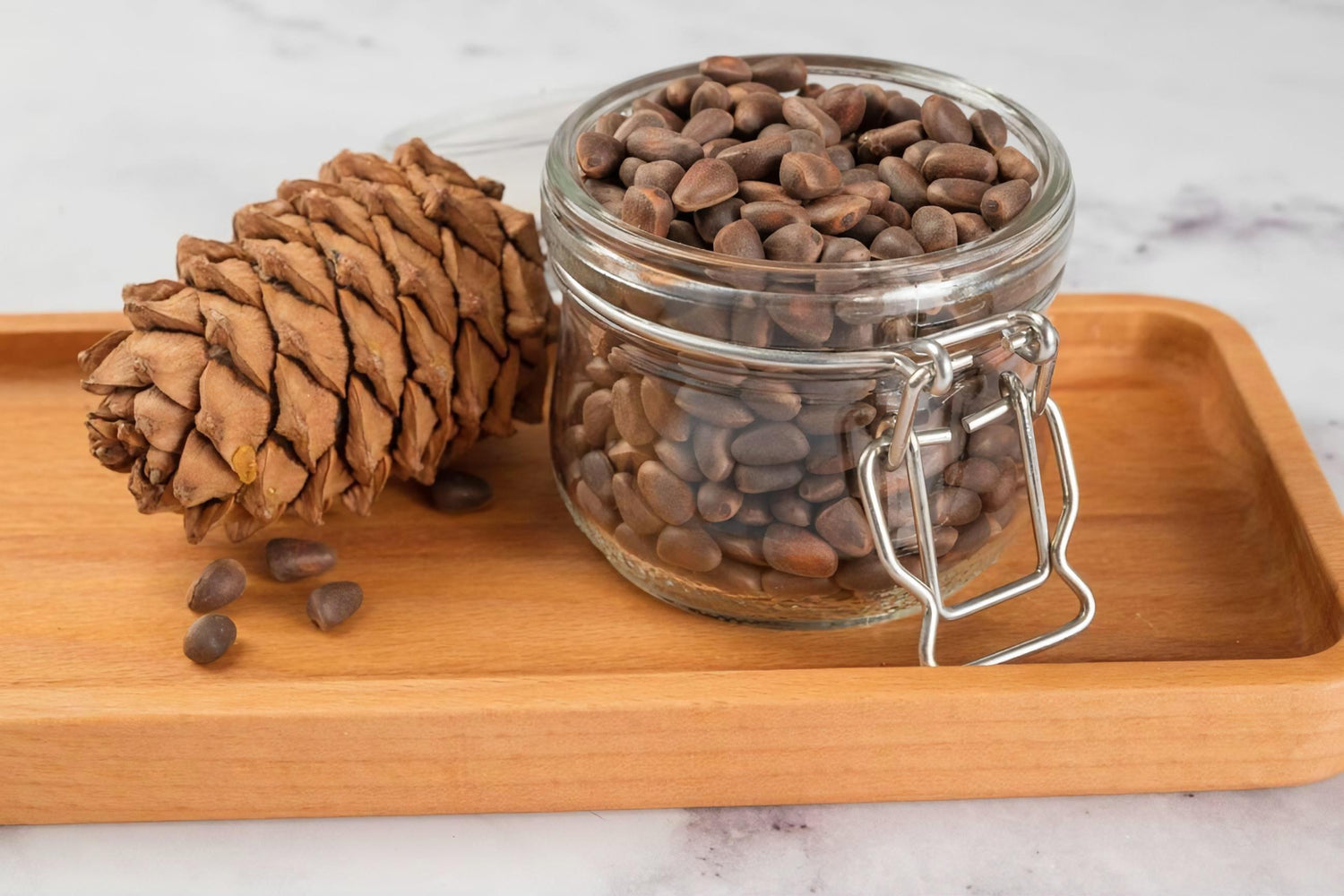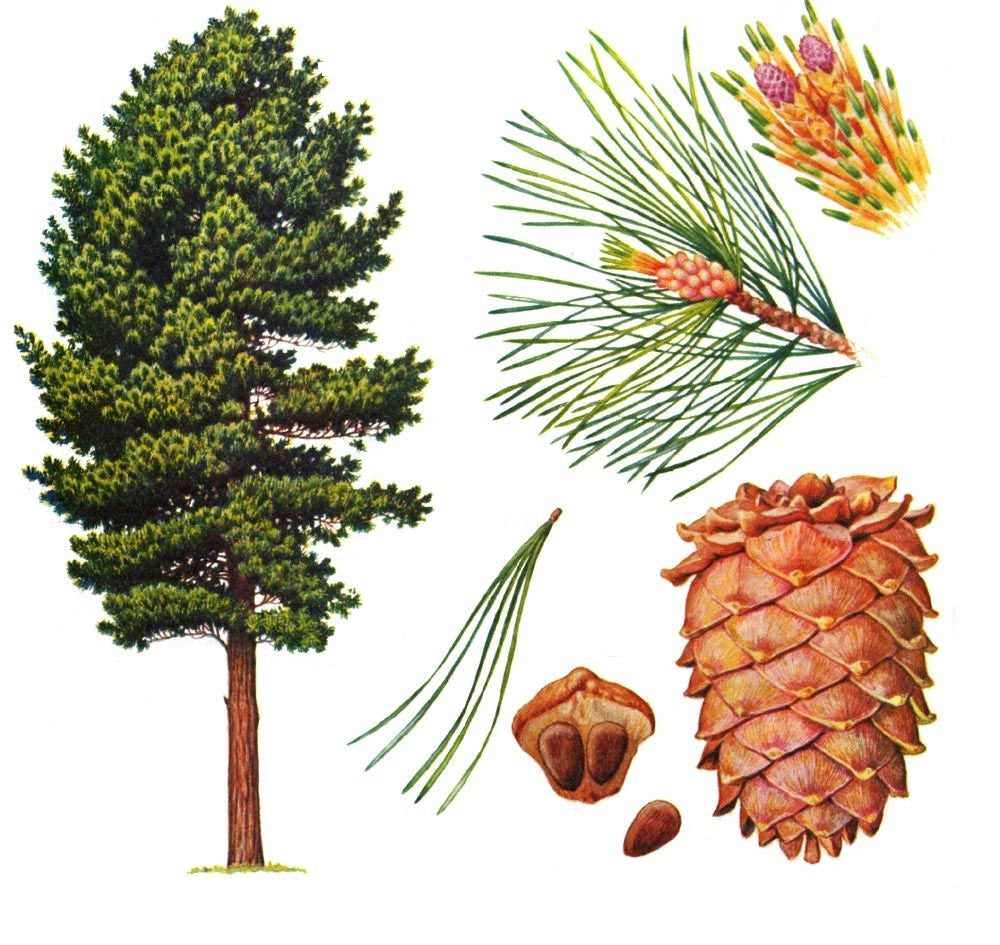The contents of this article are summarized from this source: https://jfrm.ru/en/issues/58/456 & https://jfrm.ru/files/archive/5/8.pdf
Siberian cedar nut oil, extracted from the nuts of Pinus sibirica, is a nutrient‐rich oil with unique fatty acids and antioxidants that offer science‐backed health benefits. Below is a summary of its key properties and benefits, tailored for consumers interested in its uses rooted in research.
⚠️ Clarification: Siberian cedar oil itself does not contain proteins or amino acids — these nutrients remain in the leftover kernel after oil extraction. The oil’s benefits come solely from its fatty acids, vitamins, minerals, trace minerals and antioxidants.
What’s in Siberian Cedar Oil?
The oil is composed of 62–65% lipids, with the following standout components:
- Pinolenic acid (PNLA): A rare omega-6 fatty acid (14–27% of the oil) linked to appetite control and anti-inflammatory effects.
- γ-Linolenic acid (GLA): Another omega-6 fatty acid (20% of the oil) known for skin health and reducing inflammation.
- Vitamin E: A potent antioxidant (30–32 mg per 100g) that protects cells from oxidative damage.
- Oleic acid (23%) and linoleic acid (47%), which support heart health.
Key Health Benefits
1. Reduces Inflammation
- Mechanism: PNLA and GLA suppress pro-inflammatory proteins like IL-6 and TNF-α [1].
-
Evidence:
- In lab studies, PNLA reduced markers like PGE2 (a pain-signaling molecule) by 89% [1].
- Animal trials show cedar oil lowered paw swelling by 45% in inflamed rats [1].
- Human immune cells from arthritis patients saw 60% lower TNF-α levels after PNLA exposure [1].
2. Supports Heart Health
- Lowers LDL cholesterol: GLA and oleic acid reduce oxidized LDL absorption, slowing artery plaque buildup [7] [15].
- Balances triglycerides: Cedar oil reduced blood triglycerides by 26% in animal models [1].
- Improves blood pressure: Oleic acid (similar to olive oil) promotes vascular health [1].
3. Antioxidant Protection
- Vitamin E neutralizes free radicals, reducing oxidative stress linked to aging and chronic diseases [1] [9].
- Synergy between PNLA and Vitamin E enhances antioxidant stability, prolonging their effects [1].
4. Weight Management
- Appetite suppression: PNLA boosts satiety hormones (CCK and GLP-1), reducing calorie intake by 9–36% in human trials [1].
- Animal studies show reduced weight gain and visceral fat with cedar oil supplementation [5] [12].
5. Skin and Digestive Health
- Topical use: The oil’s Vitamin E and fatty acids moisturize skin, combat acne, and protect against UV damage [6] [9] [19].
- Prebiotic effects: Promotes gut health by fostering beneficial bacteria growth, easing IBS and gastritis symptoms [2] [5].
Nutritional Profile
| Component | Role | % in Oil |
|---|---|---|
| Linoleic acid | Heart health, skin integrity | 46.7% |
| γ-Linolenic acid | Anti-inflammatory, hormone support | 20.1% |
| Oleic acid | Lowers LDL cholesterol | 23.1% |
| Vitamin E | Antioxidant protection | 30–32 mg/100g |
Safety and Usage
- No toxicity: Animal studies show no liver damage even at high doses [7].
- Dosage: Studies suggest 1–2 teaspoons daily (2–6 grams), consumed cold (never heated) [6] [19].
- Sustainability: A plant-based alternative to overharvested fish oils [1] [12].
Debunking Myths
- Proteins/amino acids: Commercial claims about amino acids in cedar oil likely refer to trace residues from unrefined oil or conflate the oil with the whole nut’s benefits. The study confirms no detectable proteins in the oil itself [1].
- Metal contact: Traditional cold-pressing avoids metal tools to preserve oil quality [6] [19].
Conclusion
Siberian cedar nut oil’s blend of PNLA, GLA, and Vitamin E makes it a potent natural remedy for inflammation, heart health, and oxidative stress. While it lacks proteins or amino acids, its fatty acid profile and antioxidant capacity offer science‐backed benefits for chronic conditions like arthritis, metabolic syndrome, and skin disorders. For eco‐conscious consumers, it’s a sustainable, multi‐purpose oil worth integrating into daily health routines.






Leave a comment
This site is protected by hCaptcha and the hCaptcha Privacy Policy and Terms of Service apply.